This is a newer disgorgement than my past bottles and
was as challenging as ever, but I felt I was ready to play. I was
knocked around for the first few rounds, but some warmth and time to
breathe brought the bottle into focus for me.
A large doughy, toasty, and racy citrus nose fills the air and declares,
“Game on.” The palate is tight and mouth puckering, but under it all
there are wonderful flavors of pear, apple, citrus, yeast, toast, and
minerals. As for the finish, it is laser sharp citrus acidity that will
knock you on your behind. When you try to get up, it will knock you down
again and again and again. I guess I am a glutton for punishment because
I like it. I ended up going the distance with this wine, but it gave me
a beating that I will remember. This is wonderful stuff that should
easily age and improve for the next 20+ years. If I had both this wine
and the one above, I would drink the 1997 Pascal Doquet and cellar this
baby. Grade of Low A- (89-91 pts) for today
with Solid A- (91-92 pts) potential over the next 10-20 years. Find this wine
…and, just for kicks, my original review of the 1996
Jean Laurent Blanc de Blancs from December of 2005 (pre-Gang of Pour
days when I was just a lost soul):
1996 Jean Laurent Blanc de Blancs
(100% Chardonnay; Celles-sur-Ource;
Disgorged March 2005; $50-65 US)
Tiny bubbles float through the light hay colored wine and make for a
very youthful appearance. The nose is, well, tight. It took a few
days for this to give me anything. Finally on day 3, it started to give
and I picked up bread notes, a touch of flower, and plenty of nut &
cream aromas. This is quite a fresh smelling wine and has a wild citrus
streak running jagged throughout. As for the taste, this is like an
everyday Joe trying to move a 350 pound NFL lineman. The lineman isn’t
giving an inch. This is not so much a tart monster as an unyielding
citrus wall that is blocking out the other flavors. I can find a few
doughy notes, a touch of peach & pear, and some clean and fresh
minerals, but this is all walled up. Even over three days, the wall is
standing strong, but there is something behind the it. It has a bit of
an exotic fruit bend to it, but I can’t see much else. The long, creamy
tart finish leaves your mouth watering and also signals that this is one
to keep your eye on.
It is way too early to really gauge this Champagne. I think this will be
very good, but when even 3 days doesn't mellow it much, I don't know how
much time it will need. Determining anything more right now would be a
crapshoot. That said, I will hedge my bets that it will be stunning and
would gladly recommend it with a warning to not drink it now. This will
be fun to check out again in 6-12 months as I think it will be easier to
figure out then. Recommended, but no grade for now.
Moet and Chandon is really pushing the Extra Dry White Star here in my
area of the US lately. I occasionally get a decent bottle of that cuvee,
but I always preferred the Brut Imperial. It never moved
me, but I recall it being a solid wine and one that rewarded a couple
years in the cellar. As it has mostly disappeared from my parts in the
last two years, I haven’t tried a bottle since 2003. I decided to crack
one and figure out if it was only absence making the heart grow
fonder.
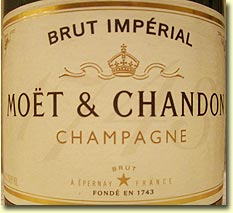 NV
Moet & Chandon Brut Imperial
NV
Moet & Chandon Brut Imperial
(50% Pinot Noir, 10% Chardonnay, 40%
Pinot Meunier; Disgorged 2005; $30-40 US)
Citrus, flowers, and earthy, fluffy peach (aka unattractive Pinot
Meunier) aromas rule the roost on this wine. Citrus elements come out
more with time, but the Pinot Meunier notes are rather dominant and not
in an attractive way. The palate, which was muddied with earthy peach and
damp leaf notes for the first hour after opening, makes a change for the
better with time. As it has time to breathe, it still shows way too much
damp earth and fluffy peach for my liking, but a nice orange led citrus
streak & a wallop of sweet creamy dough come out and put on a good show.
However, a short closing act doesn’t help things, as before you know it
the show is over and only an overly sweet and slightly bitter mineral
note remains. Day two saw most of the fruit fade and loads of sugar come
to the fore. Blind on day 2, I would have guessed this was White Star, as
it tasted like an Extra-Dry dosed towards the high end of the range.
(12-20 g/L of residual Sugar). Alas, absence did make the heart grow
fonder and I am confused as to why I even thought I might like this. It
is on par or slightly better than White Star and Nicolas Feuillatte’s NV
Blue Labels, but that isn’t saying much. This would not be on my buy
list. Oh well, at least now I won’t wonder what I never missed.
Grade of High C (75-77 pts). Find this wine
The three wines below were actually enjoyed about a month ago when I had
a few friends over to help introduce me to Burgundy. Somehow the notes
were misplaced, but now, at long last, they are here for all to enjoy.
 1988
Heidsieck & Co., Monopole Diamant Rosé
1988
Heidsieck & Co., Monopole Diamant Rosé
(50% Pinot Noir, 50% Chardonnay;
Disgorged mid 1990s; $50-80 US)
A couple of years ago this was an extraordinary Rosé, full of spicy red
berries and hints of curried biscuits. A year ago it was just as good,
but hanging onto its life by a thread. Today, the thread broke. I’ve had
about 10 bottles of this and after draining some of the bottles, I have
exclaimed that this is one of, if not the, best, Rose Champagne I have
ever had. That may be a tad generous, but it has been mighty tasty. For
the last couple years, it had faded to an orange color and lost most of
its sparkle, but this never worried me. However, this time, it was dull,
lifeless, and watered down. Light cherry and raspberry notes mix with
some biscuits, but the acidity is gone and this is bland and boring. The
most telling thing about this bottle is that it was still half full when
the other Champagnes were drained. If you have this, drink up and hope
you have a bottle that is aging a bit slower than mine have.
Grade of C- (70-72 pts), but this is over the
hill. Find this wine
 1988
Krug
1988
Krug
(40% Pinot Noir, 37% Chardonnay, 23%
Pinot Meunier; Disgorged ~2000; $175-200 US)
I love this wine. I really do. Spicy biscuits and citrus make up the
nose. The palate is full of rich, chewy nuts, biscuit, citrus, and
vanilla spice. Your mouth sparkles as the long finish takes grip and
just won’t give up. This is one for the ages and I believe it is
destined to become an all time great Krug. There is no shame in drinking
this now or anytime over the next 30-40 years. I’m glad I got a chance
to check in on this year and that I have plenty in the cellar.
Grade of A (93-96 pts) with A+ potential (97-100
pts). Find this wine
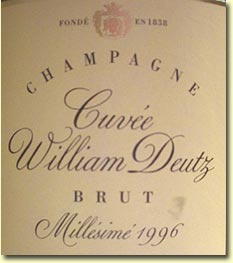 1996
Deutz Cuvee William Deutz
1996
Deutz Cuvee William Deutz
(55% Pinot Noir, 35% Chardonnay; 15%
Pinot Meunier; Disgorged ~ 2004; $100-120 US)
This was tight 1 ½ years ago and it is still tight now, but what
potential it has. Feisty citrus mixes with fresh rolled biscuit dough.
With time, more and more yeasty lemon notes come out and flow perfectly
into a long, racy, citrus finish. This is a treat today, but will have
much more to show in 10-20 years. Grade of A-
(90-92 pts) with an outside shot at a Low A (92-93 pts). Find this wine
I can’t recall having had a glass of Taittinger’s NV Brut in quite some
time so I figured I should check in on it. And… what better way to check
in on the wine then to try a fairly new bottle of it against an older
bottle. Say, 40+ years older. It was fun to compare the two bottles. Who
says basic NV wines can’t age?
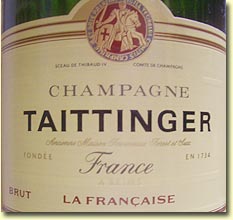 NV
Taittinger Brut (purchased in and cellared since 1964)
NV
Taittinger Brut (purchased in and cellared since 1964)
(Approximately 40% Pinot Noir, 40%
Chardonnay; 20% Pinot Meunier; disgorged early 1960s; $50-100 US)
If anyone is questioning the price above, it is for buying a well-stored
bottle of this NV blend that was first purchased in 1964. I didn’t know
what to expect, but it showed up and held its own. A
golden color reminiscent of a Sauternes graced the glass while aromas of
sherry and spice greeted my nose. The bubbles were gone, but the flavor
was still alive as sherry, butterscotch, cloves, and vanilla all made a
showing. With time, it began to fade, but who would have guessed this
would have showed so well. A wonderful experience and many thanks to
Brad Cook for sharing this bottle with us.
Grade of High B (85-87 pts). Find this wine
NV Taittinger Brut (circa 2004)
(Approximately 40% Chardonnay, 40%
Pinot Noir, 20% Pinot Meunier; Disgorged late 2004; $35-45 US)
This wine takes a while to get going, but eventually aromas of yellow
apple blossoms, minerals, and biscuit dough spiked with baking spices
come out. While the nose is always a bit closed, it is expressive in a
soft way. This is more than I can say for the palate. Creamy dough, tart
pears, and yellow pears are all there, but they are bland and hard to
find. While some time to breathe definitely benefits the wine, it can’t
help lift it up from boredom. That isn’t to say that the wine is bad. It
isn’t, it is well made and will not offend anyone, but it won’t turn
anyone on either. It lacks personality and I would rather have an
expressive wine that I don’t like, but respect, than one that I forget
in the morning. I’ve had past bottles that were better. Maybe I need to
let this age for another 40 years? Grade of
High C+ (78-80 pts).
Alfred Gratien is sometimes called a
“poor man’s Krug”. I don’t necessarily agree with that assessment (I
found a bit more of an NV Bollinger similarity), but I can understand it,
as the house philosophies are similar. One other similarity with Krug is
that Alfred Gratien recently changed the label on their NV wine. Would
this turn out to be another New Label vs. Old Label fiasco ala Krug
Grande Cuvee? Only popping the bottle will let us know. Without regard
to the wine inside, I do think the new label is very classy and
traditional looking. It is a big improvement in looks over the old,
plain, purple label.
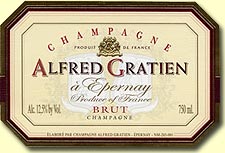 NV Alfred Gratien Brut Classique
NV Alfred Gratien Brut Classique
(Approximately 45% Chardonnay; 10%
Pinot Noir; 45% Pinot Meunier; Fermentation in oak; No malolactic
fermentation; Disgorged late 2005; $40-50 US)
A full-bodied aroma comes up at you as scents of nuts, spicy,
lemon-tinged pear, oak and a touch of sherry fill the nose.
The palate shows excellent acidity and wonderful notes of rich, spicy,
zesty pears. A full, creamy, nutty, oaky body drives the wine
home. The long finish is reminiscent of NV Bollinger Special Cuvee, as
gentle kisses of nuts and sherry mix with full bodied and slightly
creamy citrus.
I’ve always found this wine to be a great deal in the past (under the
old label) and a wine that aged very well. With the label change came
increased availability and a price increase, but this is still a good
deal and the best thing is that the wine has not changed at all. It is
still solid and enjoyable to drink now with more complexity to come with
cellaring. This is one of the most flavorful and complex NVs on the
market for under $50. Credit to Alfred Gratien for doing an excellent
job with the Pinot Meunier in this cuvee as well.
Grade of B+ (87-89). Find this wine
One recent afternoon, a box arrived on my doorstep and in it were some
new Champagne glasses. I normally sample my wine from Riedel Restaurant
Champagne. I do this for a couple of reasons. The first is consistency.
The second is that it is a good tasting glass as it has a nice tulip
shape (to accentuate the nose and palate; it is quite similar to the
high end Riedel Sommeliers Vintage Champagne) and is easily affordable
to everyone. But, I still enjoy experimenting with different glasses
especially if they are readily available and inexpensive. In the box was
a set of
Schott Zweisel Top Ten
Champagne glasses. I couldn’t wait to try them out, as they are
dishwasher safe, very hard to break, inexpensive, quite large, and
beautiful to look at, but they also show excellent potential with their
shape. So… I chose the wine below to give these glasses a run-off. I
have had this wine
before (from multiple bottles) and not been very fond of it. I
figured this would not only be a good test for the glasses, but a good
chance to check back in with the wine too.
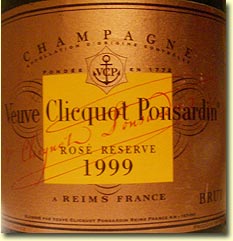 1999
Veuve Clicquot Rose Reserve
1999
Veuve Clicquot Rose Reserve
(33% Chardonnay, 55% Pinot Noir, 12%
Pinot Meunier; 15% Red Wine Addition; Mix of Premier and Grand Crus; 9
g/L dosage; $55-70 US)
Well, the wines look the same in each glass so at least I know both
glasses are made of crystal!?! As for the color, it is a very nice shade
of amber-copper. The Schott Zwiesel seems to accentuate strawberry
flowers and citrus on the nose while the Riedel brings out a bit more of
a creamy, meaty (somewhat horsey), strawberry, and biscuit note. Each
glass brings out a completely different nose and while I don’t prefer
one over the other, I find this aspect fascinating. On the palate, the
Schott Zwiesel brings out bitter citrus and a bland fluffiness that
makes the wine fall flat. While the Schott Zwiesel does not flatter this
wine, the Riedel makes it much more acceptable. Flavors of
raspberry, red grapefruit, and strawberry cream mix with some bitterness
and dirt. It isn’t a great wine in either glass, but the Riedel matches
it much better and brings out a bit of Burgundian character. A drying tart citrus and strawberry finish closes out
in the Schott Zwiesel while a lively red citrus and drying, earthy
biscuit note closes out the Riedel glass.
One final note on the wine (and not the glasses), time does not seem to
do this well, as the longer the bottle was open, the more a bitter
acidity seemed to come to the fore in both glasses as the fruit faded
and became a tad muddled and a bit dirty. I wouldn’t age this.
It is quite amazing how different these two glasses make this wine
appear. I preferred the Riedel over the Schott Zwiesel for this one,
but I think each glass will suit a different style. More testing is
needed to make any conclusions, but my instinct leads me to believe that
the Riedel will do better with meaty, biscuity, earthy wines while the
Schott Zwiesel will really show off fruit forward, floral wines. As for
mature vs. youthful Champagne in these glasses, I will have to leave
that challenge for another day.
Overall, the wine was not that tasty in either glass and gets a Grade of
B- (80-82 pts) in the Riedel glass and a Grade
of C+ (77-79 pts) in the Schott Zwiesel glass. Find this wine
I’m not a fan of the Madonna clothing on this bottle, but I am a fan of
the juice inside it. The dressed up bottle is a bit tacky and an odd
marketing ploy, but you can’t judge a book by its cover. Along with its
odd appearance, the lack of a vintage, a high price, and discontinued
production often lead this bottle finding a home in the discount bin.
So, ugly bottles can be a good thing. Outside of its appearance, what I
have always wondered about is the makeup of the wine. It shares the same
grape composition as the regular Piper-Heidsieck NV Brut, but that is
where the similarities end. This is definitely a high end bottle, but it
is very different from Piper’s tete de cuvee “Rare.” Where Rare is racy
and sometimes a bit exotic, the Cuvee Speciale is a NV
Daniel Thibault wine on steroids. I’ve
tried to get the whole story behind this and what exactly goes into
making it, but no one seems to be talking. My guess would be that this
sees more time aging on its lees, older reserve wines, and/or some wood
aging.
 NV
Piper-Heidsieck Cuvee Speciale Jean Paul Gautier
NV
Piper-Heidsieck Cuvee Speciale Jean Paul Gautier
(15% Chardonnay; 55% Pinot Noir; 30%
Meunier; Lot 00305; Disgorged ??; $60-100 US)
Rich aromas of peach, citrus, apricot, and vanilla laced dough greet
you on the pour. It is quite a trip, as it smells youthful, yet very rich
and a touch mature at the same time. The palate meshes seamlessly with
the nose and carries this same trend throughout the wine. Hints of
biscuit mix with rich orange, peach, pear, and dried apricot. With time,
a wonderful citrus tinged minerality weaves its way in. This minerality
also comes through on the finish where it joins in with zesty, slightly
bitter orange in an attempt to drive the wine home. However, the RBI
attempt is not successful as I’m left lacking the rich notes that made
the nose and palate so enticing.
Despite a slight letdown on the finish, this is a fine wine that should
improve over the next 5-10 years. I’m not sure it is worth the money at
full price, but if you get a good deal on closeout, I think it is worth
a go. Grade of High B+ (88-90 pts) with the
possibility for improvement to a Low A- (89-91 pts).
Find this wine
Cheers!
Brad Baker
BACK TO THE TOP
BACK TO BRAD BAKER'S
INDEX PAGE
March 2007 © Brad Baker


 1997
Pascal Doquet Blanc de Blancs
1997
Pascal Doquet Blanc de Blancs 1996
Jean Laurent Blanc de Blancs
1996
Jean Laurent Blanc de Blancs NV
Moet & Chandon Brut Imperial
NV
Moet & Chandon Brut Imperial 1988
Heidsieck & Co., Monopole Diamant Rosé
1988
Heidsieck & Co., Monopole Diamant Rosé 1988
Krug
1988
Krug 1996
Deutz Cuvee William Deutz
1996
Deutz Cuvee William Deutz NV
Taittinger Brut (purchased in and cellared since 1964)
NV
Taittinger Brut (purchased in and cellared since 1964) NV Alfred Gratien Brut Classique
NV Alfred Gratien Brut Classique 1999
Veuve Clicquot Rose Reserve
1999
Veuve Clicquot Rose Reserve NV
Piper-Heidsieck Cuvee Speciale Jean Paul Gautier
NV
Piper-Heidsieck Cuvee Speciale Jean Paul Gautier